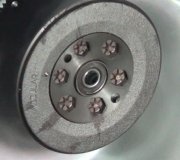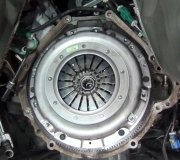Welcome to 2CarPros.
Have you checked transmission fluid level and condition? Also, has the check engine light stayed on when the engine is running?
As far as the transmission fluid, here are the directions for checking the fluid. Do this first. Let me know the condition and color of the fluid when you check it.
2003 Mitsubishi Truck Montero V6-3.8L SOHC
Fluid Inspection
Vehicle Transmission and Drivetrain Automatic Transmission/Transaxle Service and Repair Procedures Fluid Inspection
FLUID INSPECTION
TRANSMISSION FLUID CHECK
1. Drive the vehicle until the transmission fluid temperature rises to the normal temperature [70 - 80°C (158 - 176°F)].
2. Park the vehicle on a level surface.
3. Move the selector lever through all positions to fill the torque converter and the hydraulic circuits with fluid, and then move the selector lever to the "N" position.
4. After wiping off any dirt around the dipstick, remove the dipstick and check the condition of the transmission fluid.
NOTE: If the transmission fluid smells as if it is burnt, it means that the transmission fluid has been contaminated by fine particles from the bushings and friction materials. A transmission overhaul and cooler line flushing may be necessary.
Pic 1
5. Check that the transmission fluid level is at the "HOT" mark on the dipstick. If the transmission fluid level is less than this, add DIAMOND ATF SPIII or equivalent transmission fluid until the level reaches the "HOT" mark.
NOTE: If the transmission fluid level is too low, the oil pump will draw in air along with the transmission fluid, which will cause bubbles to form. If the transmission fluid level is too high, rotating components inside the transmission will churn the fluid and air into a foamy liquid. Both conditions (level too low or too high) will cause the hydraulic pressure to drop, which will result in late shifting and slipping of the clutches and brakes.
In either case, air bubbles can interfere with normal valve, clutch, and brake operation. Also, foaming can cause transmission fluid to escape from the transmission vents where it may be mistaken for a leak.
6. Securely insert the dipstick.
NOTE: The transmission fluid should always be replaced under the following conditions:
When troubleshooting the transmission
When overhauling the transmission
When the transmission fluid is noticeably Jiffy or burnt (driving under severe conditions)
Let me know what you find.
Joe
Image (Click to make bigger)
Tuesday, October 29th, 2019 AT 7:27 PM



